4 Ecosystem Processes: Water Cycle
Water: A Love Story
Relationships are a funny thing. On the one hand, most of us prefer to hang out with people that share our hobbies, sense of humor, spiritual beliefs and political views. On the other, we often end up in the most intimate friendship that exists, marriage, with someone who is very different than ourselves. We even have a saying for it: opposites attract! What’s even more interesting is that opposites attract all throughout our world, not just in our human relationships. Some of the best examples of this relational principle come from non-living entities, like atoms, that are attracted or repelled from one another. In fact, there exists a three actor love-story taking place all over our universe that makes Romeo and Juliet look like childsplay. We call this cosmic ménage à trois “water”.
Water, one oxygen atom attached to two hydrogen atoms, is the most common molecule in our universe by a longshot.1 Like any good relationship, both parties have something to offer the other. Oxygen needs two electrons to be satisfied and hydrogen atoms are more than happy to donate their one extra electron. Voila, H2O! Because electrons are negatively charged and oxygen essentially hogs two of them, a negatively charged zone forms around the oxygen atom, while a positive zone forms around each hydrogen. These magnetic “polar” regions of water are attracted to each other like positive and negative ends of a magnet, once again proving that opposites attract! Plants use this to their advantage by creating a long chain of water molecules from their leaves down to the roots. As water evaporates out of the leaf, a tug pulls the chain of water upward via capillary action, which results in less water present at the end of the chain (a.k.a the root tips). Water then moves inside the root to even out the ratio of salts to liquids inside and outside of the root. The same principle explains why pouring salt on cabbage prior to making sauerkraut causes it to “sweat” out water.
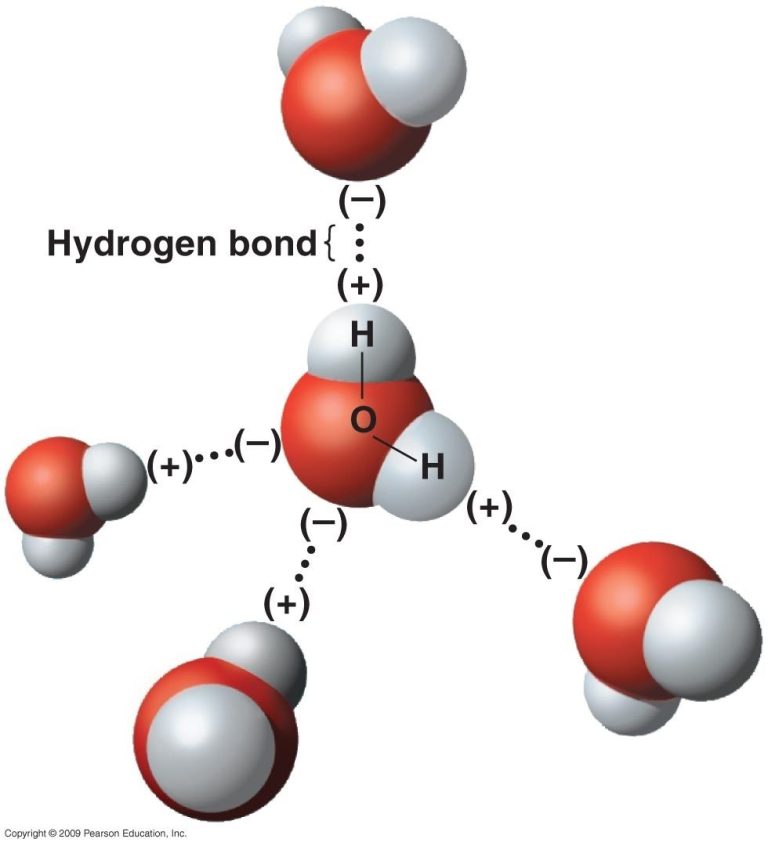
You probably already know this from news clips, but water is one of the first molecules that scientists look for on Mars and other planets. While water is important in its own right, scientists are really checking to see if the ingredients are right for life to exist, and it turns out that the first condition that needs to be met is the presence of water. No water, no life. It’s as simple as that. Water is necessary because its abundance and polarity make it the “universal solvent”, meaning organisms use it to effectively break down compounds and transport them to where they’re needed. This is essentially what happens in our blood and plant vascular tissue.
Another important function of water is that it maintains internal and external structure of cells. Internally, water creates pressure that pushes outward like air in a filled up balloon. In biology, this is known as turgidity. Cells need this structure to function correctly. Issues arise when the amount of water outside of the cell drops, such as during a drought when plants have no more water to drink. When this happens, water will naturally leave the cell to even out the concentration of solids, which collapses the cell like a fallen down circus tent. Excessive water is also an issue and can cause water to rush in to cells too quickly and burst the cell. Water influences cell structure from the outside by helping to organize a cell membrane, which surrounds every living organism on Earth. Cell membranes behave like a skin to keep good things in, bad things out and act as a channel to allow transfers from both sides. This “phospholipid bilayer” has a polar region (phosphate head) and a non-polar region (fatty tails). Because of water’s abundance inside and outside of the cell, as well as its polar nature, the polar region of the phospholipid points outward while the non-polar, fatty region avoids the water and points inward. Think about how oil (made of fat molecules) doesn’t mix well with water.
Lastly, water is necessary for many cellular processes to occur, including protein folding, maintaining DNA’s double helix shape, photosynthesis, pH buffering and many, many other processes.2 No water, no life.
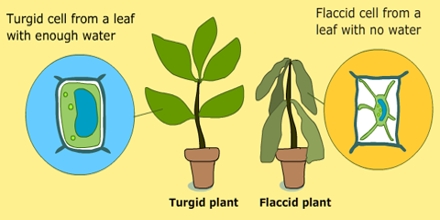
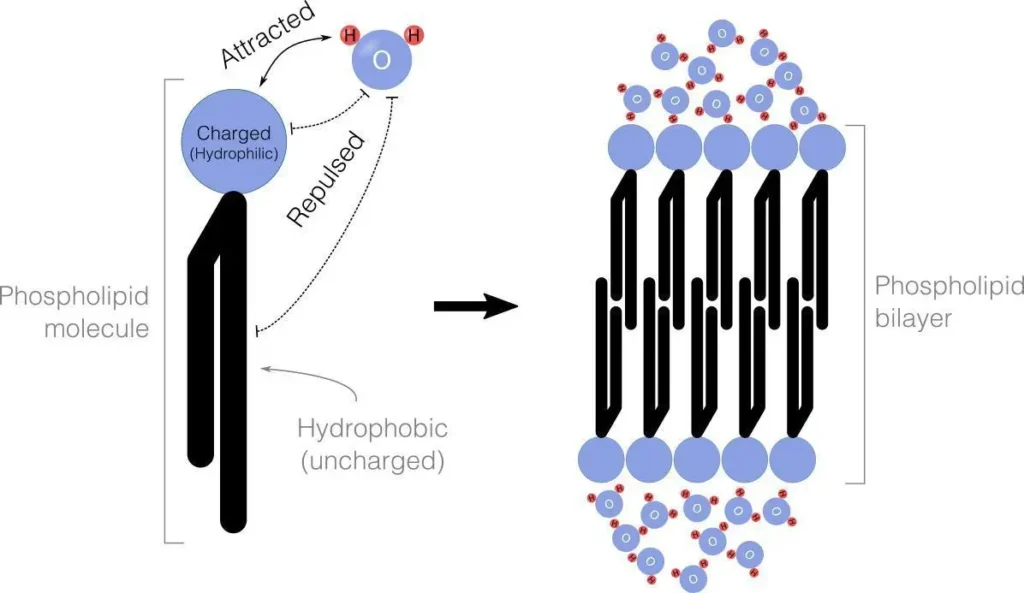
Water also affects many abiotic (non-living) processes, such as heat transfer, which is due to the spherical shape and tilt of our planet (sorry Flat-Earthers). Sunlight hits the Earth near the equator at a near 90 degree angle, which provides a more concentrated amount of energy to the land compared to regions closer to the poles. Think about using a flashlight in the dark. Point it straight down at a 90 degree angle to the floor and the light is concentrated in a small circle. As you move the circle of light away from you, the light stretches across a larger area of the floor, thus diluting the energy that falls on a given area. So, more energy received toward the equator means more energy is absorbed by water, which becomes gaseous water vapor in the atmosphere. This heat-containing vapor travels from tropical regions to polar regions, creating a heating effect like how heat is released from hot water in a furnace and warms up the room.
Weathering and erosion are two other important abiotic processes driven by the water cycle that keep life moving. As with many aspects of ecology and biology, there tends to be a Goldilocks Zone where life is balanced and healthy. We need weathering and erosion by water to keep nutrients flowing throughout the landscape, but we also can’t afford it to be too quick or we will lose more nutrients than we put back. After all, water is one of, if not the most, destructive forces on Earth. It’s amazing to think how something so gentle and harmless like water can carve out the mighty Grand Canyon in Arizona, which stretches for 277 miles and is up to a mile deep in some parts! Fred Flintstone could only imagine what it looks like today. Water in the form of raindrops can also compact the surface of a bare soil, thus decreasing the amount that is infiltrated and increasing topsoil erosion.
Our relationship with water can either be nourishing and life-giving or a frustrating, on-again-off again fling that can tear down civilizations in the blink of a geologic eye. Just ask the early Mesopotamians3 around 2200 BC or the Mayans around 900 AD4,5,6. The good news is that we know a lot more about the way water cycles and the agricultural practices that we can implement to infiltrate, store and use water more efficiently for increased plant production. We have agency to transform our land into resilient production sites that can better withstand drought and deluge. In other words, the way we manage the land largely determines our relationship status with water.
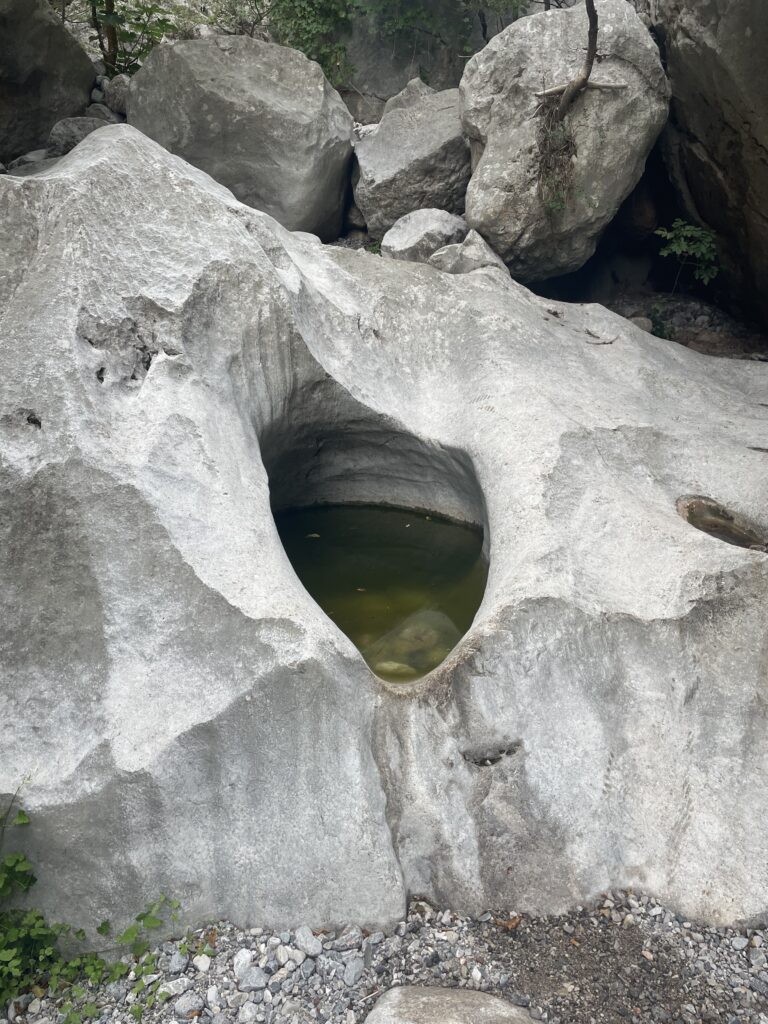
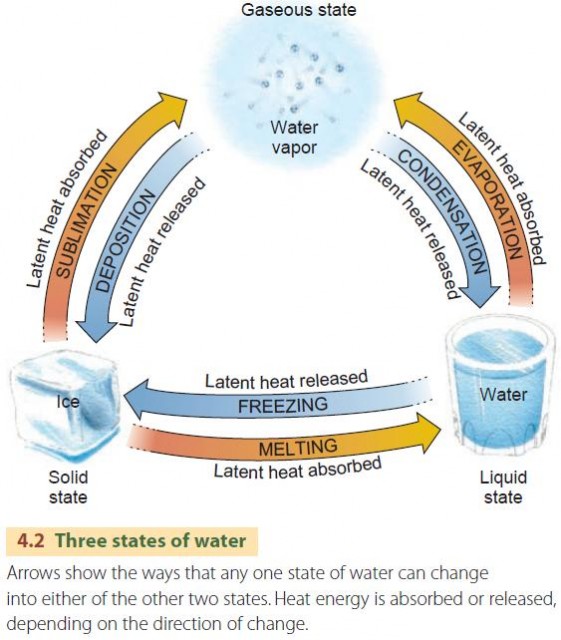
Large Water Cycle
From the core to the outer edge of the atmosphere, Earth contains 332 million cubic miles of water molecules. This amount stays fairly constant over time. What changes is where that water is located and its phase (whether it’s a gas, liquid or solid). Today, water covers 75% of the Earth’s surface in liquid or solid form, with the vast majority being salty ocean water. The Large Water Cycle uses the ocean as a reference point and refers to the macro-level cycling of water from the oceans, onto the land and back to the oceans. The Small Water Cycle refers specifically to water that cycles inland. With as much water as there is on the planet, it’s not hard to imagine that the cycling of water is the largest movement of a chemical substance at the surface of the Earth.7 This annual circulation of water does not happen on its own, as it is fueled by incoming energy from the sun. Liquid and solid water on the surface of the planet absorbs incoming sunlight energy and evaporates into the atmosphere as a gas (water vapor). Temperature and pressure changes in the atmosphere cause water to condense back into a liquid, forming clouds and eventually precipitation. Water that reaches the Earth’s surface can take a few different routes. It can go up: immediately evaporate and return to the atmosphere as a gas, sideways: runoff and flow the watershed, down: infiltrate into the soil or stay put: get held in the soil. Water that flows into streams, lakes and rivers eventually finds its way to the vast seas and oceans of the planet where it can once again evaporate into the atmosphere. Infiltrated water, on the other hand, can be adsorbed onto mineral particles or taken up by living organisms. Water that evades mineral polarity and biological thirst percolates deeper into the ground, where it continues to travel through the subsoil and seep through cracks in the bedrock. Once here, gravity may take this “groundwater” downhill, which contributes to river baseflow and can even resurface as part of a pond or lake, where it may evaporate back into the atmosphere. Another option is for water to reach an underground cavity where it pools into reservoirs of groundwater called aquifers. Irrigation and other well-drilling technology taps into this crucial source of freshwater, where it can be applied for our use on the surface. Eventually, water reaches the ocean through rainfall or river flow, thus completing the cycle!
Similar to carbon in the energy cycle, water molecules can find themselves cycling faster or slower depending on their location. Many water molecules cycle quickly and travel far distances in a short amount of time, while others may find themselves locked inside of a glacier for thousands of years. In either case and every case in-between, water is constantly on the move. This endless cycling is healthy for the planet as it purifies water, redistributes nutrients and ensures life has the water necessary to flourish. In fact, water availability is the most important factor that determines the growth of plants, which are the base of the energy pyramid on most terrestrial landscapes. Plants subsequently increase water availability and cycling over time in a positive feedback loop. More on this in the Small Water Cycle.
The point is that life on the planet wouldn’t exist without a functioning Large Water Cycle. It’s humbling to think that we owe our very existence to something that we didn’t design and moves along with or without us. However, this does not relieve us of our duties to steward water well. While there are some astronomical and climatic aspects of the Water Cycle we can’t do much about, there are plenty of others within our agency that do affect cycling of water on Earth. In fact, human management of the land has impacted the Water Cycle on a global scale since the inception of agriculture and its expansion across the globe. Author David Montgomery details many ancient and modern ecological crises in his book, Dirt: the Erosion of Civilizations, which serves as a cautionary tale that our collective management of the land directly affects water availability for agricultural production.
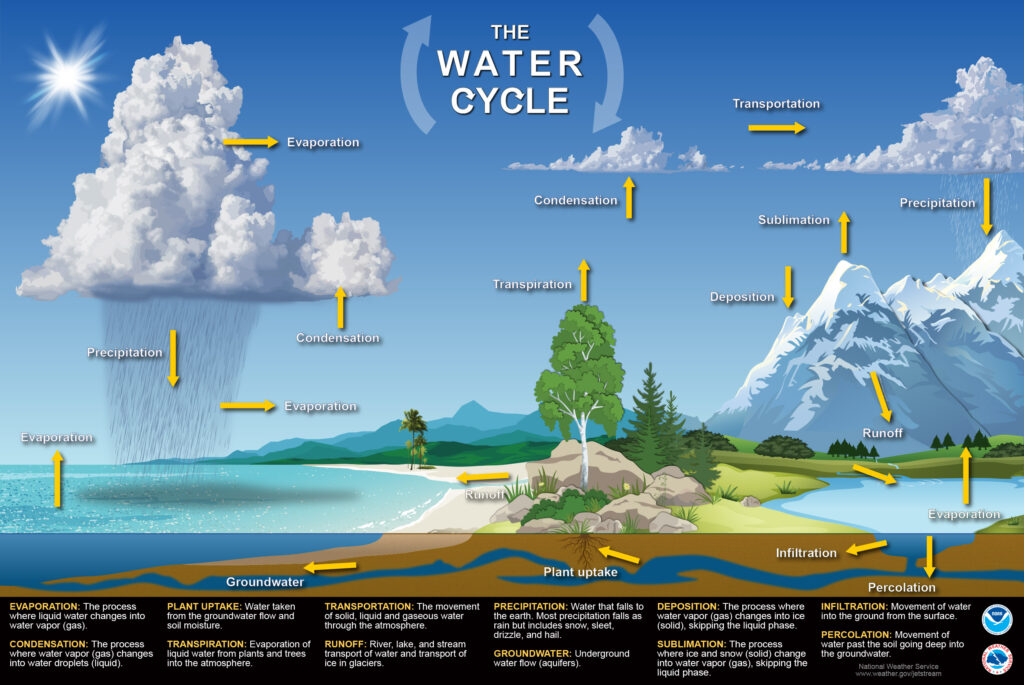
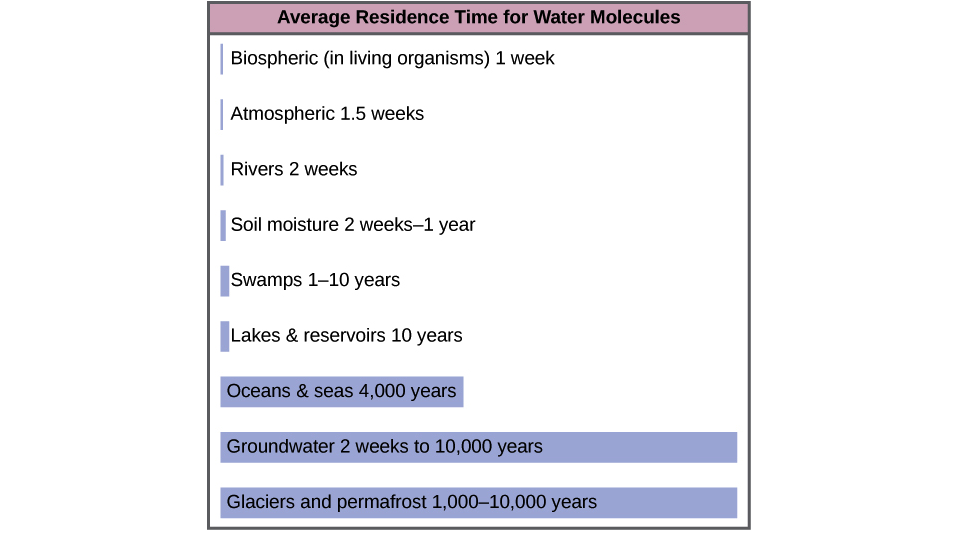
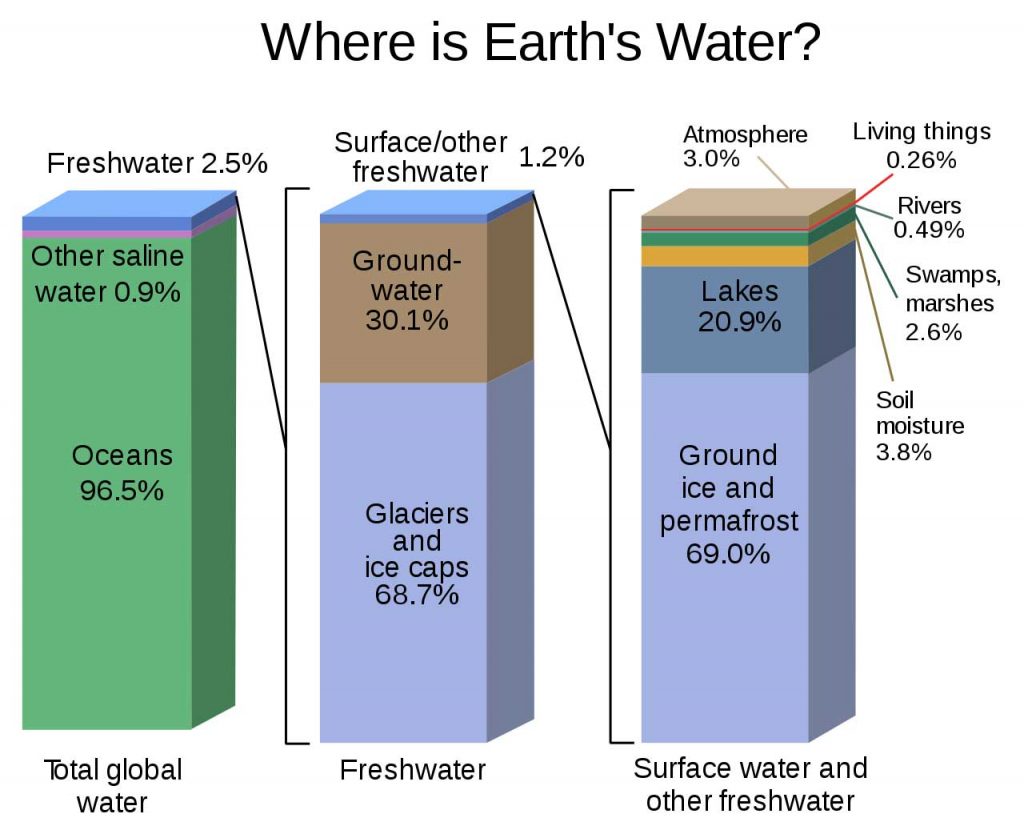
Small Water Cycle
The aforementioned Large Water Cycle is taught to us from a very young age. It’s ingrained in us that water moves. What isn’t taught to us is the connection between soil health, water availability, plant productivity and weather patterns. This inland cycling of water is what many refer to as the Small Water Cycle. Whatever you call it, green, growing plants are necessary for water to cycle efficiently on land. Without them, the Small Water Cycle quickly breaks down. Vast stands of trees, in particular, create the right conditions for water to ebb and flow throughout the landscape. What’s amazing to me when I learned this is that observant humans have known this for hundreds, if not thousands, of years! For example, Ferdinand Columbus, son of Christopher Columbus, wrote this entry in his travel journal over 500 years ago: “On July 22nd, 1494, Columbus departed for Jamaica… Every afternoon there was a rain squall that lasted for about an hour. The admiral attributes this to the great forests of that land; he knew from experience that formerly this also occurred in the Canary, Madeira, and Azore Islands, but since the removal of forests that once covered those islands they do not have so much mist and rain as before.”8 George Perkins Marsh observed a similar response to deforestation in his 1864 book Man and Nature. He writes, “When the forest is gone, the great reservoir of moisture stored up in its vegetable mould is evaporated, and returns only in deluges of rain to wash away the parched dust into which that mould has been converted. The well-wooded and humid hills are turned to ridges of dry rock.”9 Historical insights such as these are crucial to understanding that our management of the land does indeed affect weather patterns.
Here’s the science behind it. Plants, just like all living organisms, are mostly composed of water. They contain continuous chains of water that run from their roots all the way up to their leaves. These chains terminate at openings on the leaf called stomata that take in carbon dioxide from the air and turn it into food for itself during photosynthesis. Water simultaneously exits the leaf as water vapor (steam) each time a stomata opens up to vacuum in carbon dioxide, in a process called transpiration. As it turns out, the vast majority of water taken up by plant roots is transpired toward the heavens, leaving as little as 0.1% of the water to be used in the construction of plant tissue.10 In his Ted Talk titled, “The magic of the Amazon: A river that flows invisibly all around us”, Brazilian scientist Antonio Donato Nobre describes plants as living geysers because they send water from the ground into the atmosphere just like Old Faithful, only with less violence and visibility. In the Amazon, billions of geyser-plants in the form of trees pump 20 billion metric tons of water into the air via transpiration each day, which is more than the daily amount of water the Amazon River dumps into the Atlantic Ocean (17 billion metric tons)!11 These transpired molecules of water band together into airborne rivers and travel along the jetstreams where they can fall as precipitation in other regions. Some climatologists even believe that pockets of water can accumulate as “aerial lakes” that behave like a reservoir of atmospheric water.12 There’s a whole lot going on up there that we are just now discovering!
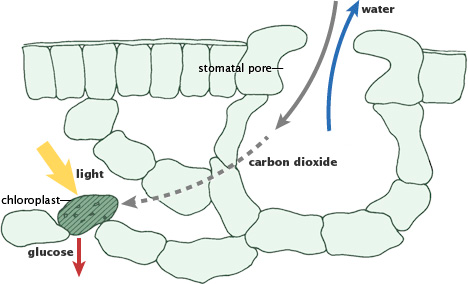
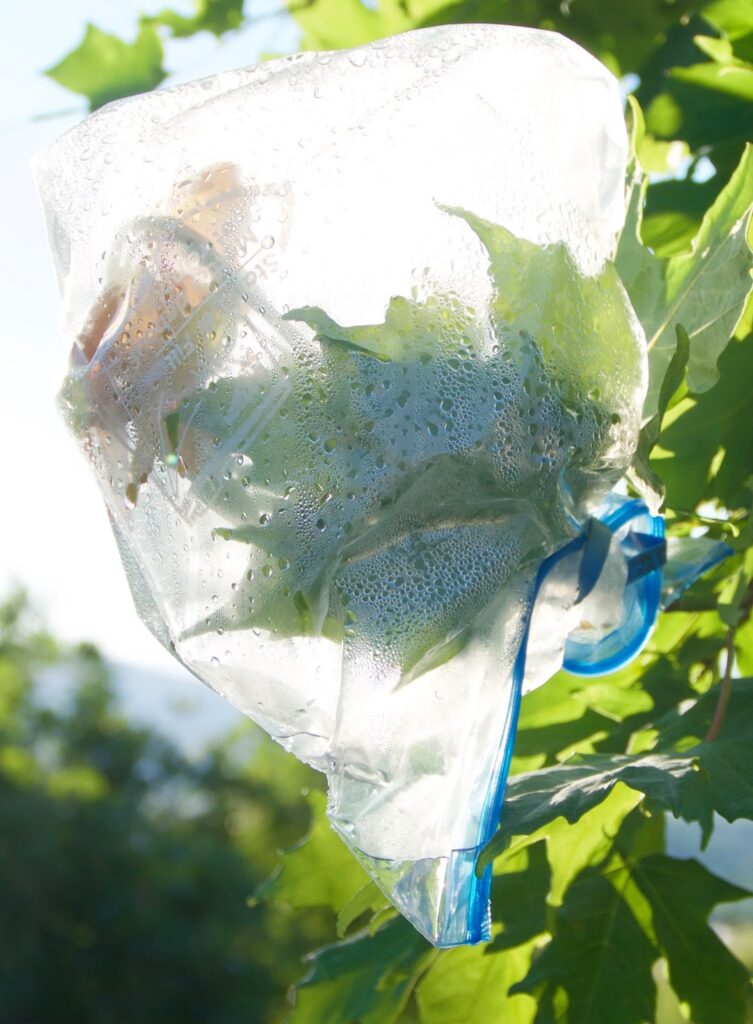
It seems the scientific community is beginning to understand what indigenous people and observant travelers have known for ages: plants play an active role in creating rain. They are not and have never been passive observers. Nobre even goes so far as to say we should think about trees in the Amazon as if they are the heart that pumps blood to the rest of the body as water is pumped upward from the trees where it can then flow to the rest of the body via aerial arteries and rain on other parts of the body. Water eventually flows back to the oceans via the streams and rivers that look and function like our veins. Plants can then draw water from the ocean to the land, take it up through their body and start the loop over again. It’s a beautiful description, but is it true that plants draw water inland from the ocean? It seems to be the case for large stands of trees, which some scientists now call “biotic pumps”.13 As water transpires into the atmosphere, it cools and condenses. This condensation creates a low pressure zone around it. This is key. Massive quantities of condensed water over forests creates a huge low pressure zone. This difference in air pressure catalyzes atmospheric movement of air from areas of high pressure over the water to the low pressure zone on land. Moist oceanic air continues to flow in that direction over time because forests like the Amazon transpire more water than the nearby oceans evaporate, which means continuously lower pressure over the land.14 This sets off a chain reaction that moves water from the ocean to the forest and finally to the land where it can water regions far away from major bodies of water. That is, of course, assuming the forest is left intact. Preliminary research is showing that felled forests decrease regional precipitation.15,16 Time will tell the scale of disruption.
Although trees are incredibly important in the Small Water Cycle, green plants of all shapes and sizes have a role to play in the cycling of water on land. In fact, research shows that respiring plants all across the globe account for 80-90% of water that returns to the atmosphere. The rest is from evaporation of surface water sources, like lakes and rivers.17 Transpired water from plants also differs from surface water evaporation in that plants release unique microbes and organic compounds along with transpired water. This is crucial to the formation of rain because atmospheric water vapor needs an object to form around. Scientists call this a condensation nucleus. These nuclei typically range from a few microns to a few tenths of a micron in size (one micron equals 10-4 centimeter). It turns out that plant-emitted bacteria18,19, scents in the form of carbon-based volatile organic compounds (VOC)20,21and even pollen22 are excellent nucleation sites for water vapor to rally around. The Smoky Mountains of the Eastern United States are a great example of this cloud-forming phenomenon!23
These plant-originating nucleation sites are likely a major contributing factor in increased cloud production and precipitation on land compared to skies above large bodies of water. In yet another example of positive compounding and cascading effects, plant life begets more plant life through the creation of rain from its airborne condensation seeds. However, not all airborne particles encourage condensation. The three major sources of aerosols in the atmosphere are desert dust, smoke from biomass burning, and anthropogenic (human-caused) air pollution, all of which are known to suppress precipitation.24 Deforestation and bare ground are two practices that discourage rain and water infiltration during rain events, which can set off a set of negative compounding and cascading effects referred to as “desertification“.
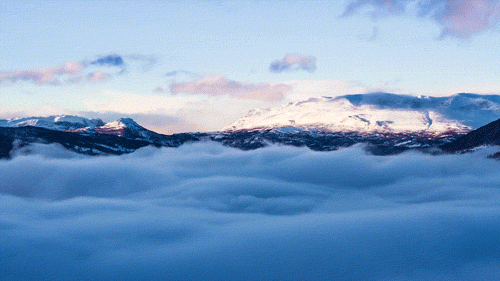
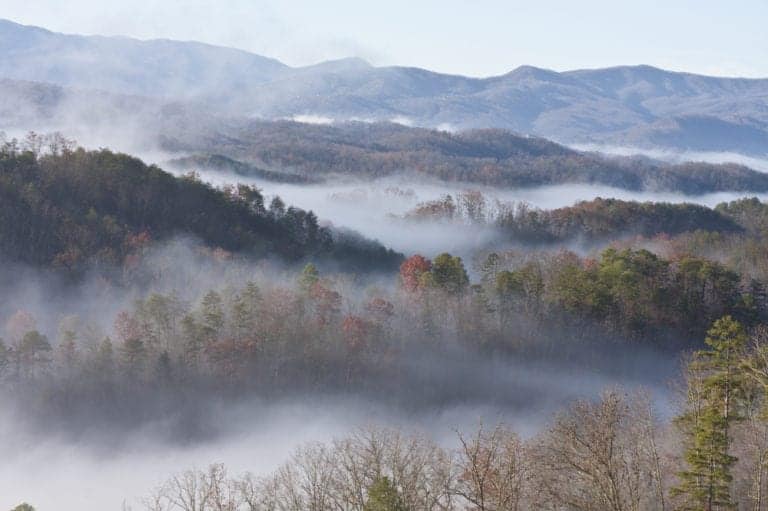
Water & Energy Cycles
Remember how water has a negatively charged pole and a positively charged pole? The attraction of positive to negative poles in water is called a hydrogen bond, and there are an unfathomable amount in just a single glass of water. Heat absorbed by water has to break apart these countless hydrogen bonds before it can raise the temperature of water, which explains why it takes more energy to heat up water than any other substance on Earth. This is called water’s specific heat capacity. According to Khan Academy, “the specific heat capacity of water is about five times greater than that of sand. The land cools faster than the sea once the sun goes down, and the slow-cooling water can release heat to nearby land during the night.”25
For this reason, and the sheer quantity of water in the air, water vapor is the most important gas that affects our planet’s temperature, as it traps about half of the heat we need to survive. Temperatures on the ground would be nearly 59 degrees Fahrenheit (33 degrees Celsius) colder without atmospheric water vapor trapping heat sent by the sun!26 In addition to preventing heat from exiting back out to space too quickly, the cycling of water affects roughly 95% of Earth’s natural heat dynamics (i.e. how heat moves once it enters the atmosphere).27 Many of us probably think carbon dioxide is the largest driver of Earth’s natural heat dynamics, but it’s actually good ol’ H2O! Nonetheless, carbon dioxide is still an important greenhouse gas that influences planetary temperatures. The main difference between water and other greenhouse gases like carbon dioxide is that water cycles much more quickly in and out of the atmosphere, lasting only about a week and a half before it moves somewhere else. Water is constantly absorbing heat from one location and releasing it in others, which is why one scientific paper writes, “Water vapor arguably lies at the heart of all key terrestrial atmospheric processes.”28
With all of that in mind, let’s consider two scenarios: First, we will explore what happens to energy from the sun that lands on a green plant capable of photosynthesis. Some of this energy is transferred into the sugars it produces and some is used to evaporate liquid water out of it leaves as water vapor, a.k.a steam. Just like a pot of water needs energy to produce steam, plants also need energy to release vapor. This “latent heat” inside of the vapor is then carried away inside of water, which cools the plant in the same way our sweat cools us down. Every gram of liquid water carries away 590 calories of latent heat energy which was used to transform it into a gaseous form. Eventually, this water vapor will condense in the atmosphere back into a liquid, a process which releases its latent heat. Water then falls downward to Earth and the latent heat rises upward into space. Plant physiologist Dr. Jan Pokorný. calls this process the “perfect and only air conditioning system on the planet. Ecosystems use solar energy for self-organization and cool themselves by exporting entropy to the atmosphere as heat. And the medium for all of this is water.”29
Think back to the 20 billion metric tons of water that are transpired in the Amazon every day. If those 20 billion metric tons of water were to be placed in an electric kettle, it would take the power produced from 50,000 of the world’s largest hydroelectric plant, Itaipu, to turn that liquid into steam.30 The trees of the Amazon do this every day for free in a clean, efficient manner that purifies water and moves it along.31 This keeps the Amazon cool and damp even though it’s located at the equator. On the farm-scale, this evapotranspiration from living plants has a similar cooling effect, which is especially important when trying to keep livestock cool in the summer. Our underground livestock also benefit from the physical shading and transpiration of living plants, which works to maintain soil temperature in a pleasant range.
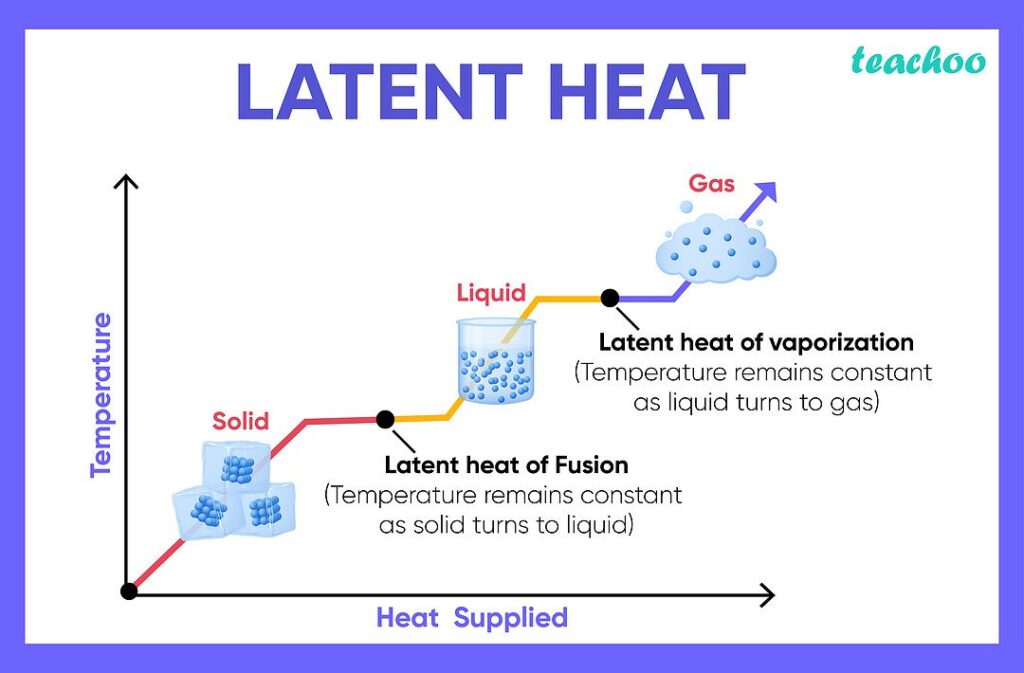
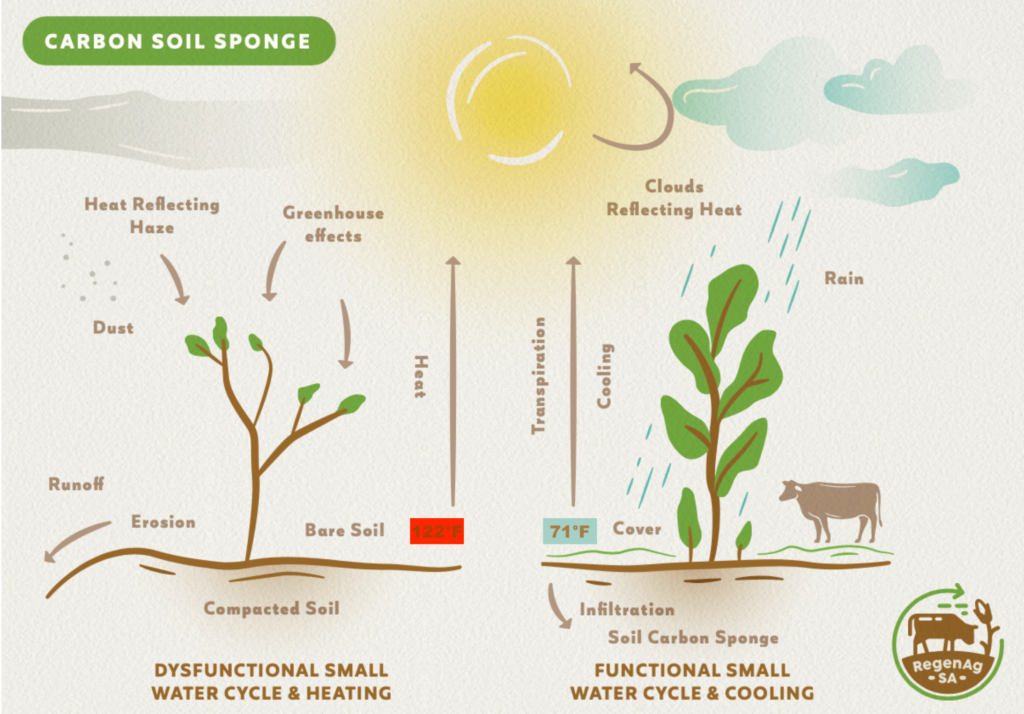
The second scenario we need to think about is solar energy that falls on land but does not get captured by a green, growing plant or other photosynthesizing organism. One option is for it to land on urban development like sidewalks, streets and buildings. Unless there is an excessive build-up of moss or algae on them, there is likely no chlorophyll to capture the sunlight on these surfaces. More likely is that heat will be absorbed by the molecules in the shingles, concrete, asphalt and other building materials and reradiate a lot of the heat back out, which creates a dramatic change in temperature. Scientists use the term sensible heat to describe this heat that results in a change of temperature, as opposed to latent heat that did not change temperatures. We’re already familiar with this concept of sensible because we choose to walk in the grass during the heat of the summer when we are barefoot as opposed to the sidewalk which gets blistering hot! It’s also a known fact that “heat islands” emerge around urban areas as temperatures tend to be 1-7°F hotter than surrounding countryside32, which can greatly alter precipitation patterns.33 Before any of you rural folks hop on your high horse, there are plenty of non-photosynthesizing landing zones out in the country as well. Sunlight energy that lands on deserts, bare fields or even bare spots between plants will also radiate sensible heat. While most soils contain energy-absorbing water, most of it can evaporate off as steam, leaving sands, silts and clays to do the majority of heat absorption. These materials are simply worn-down rock, so it makes sense they absorb and radiate heat similarly to our sidewalk example. In fact, up to 60% of solar radiation that falls on dry land can be lost as sensible heat compared to 80% of solar radiation that is transformed into latent heat on watered land.34
During the night, urban surfaces and bare soil lose their heat very quickly. For example, temperatures on the moon’s surface, which is just sands, silts and clay, can vary from 260°F (127°C) during the day to -280°F (-173°C) at night.35 Thanks to our atmosphere, deserts on Earth experience much smaller variations in temperature, such as in the White Sand Dune field of New Mexico which ranges from 95°F (35°C) during the day to -19°F (-28°C) at night.36 Temperatures of bare soil, a cousin of deserts, can vary up to 17°F in early May from daytime to nighttime at a depth of 4 inches.37 Planting crops in the spring depends on appropriate soil moisture and soil temperature, so this wide variation may cause issues with seed germination and establishment. A few months later, bare soil will absorb energy from the hot summer sun and temperatures will be much hotter than ambient air temperature during the day, which can cook helpful microbes just when we need them most.38,39
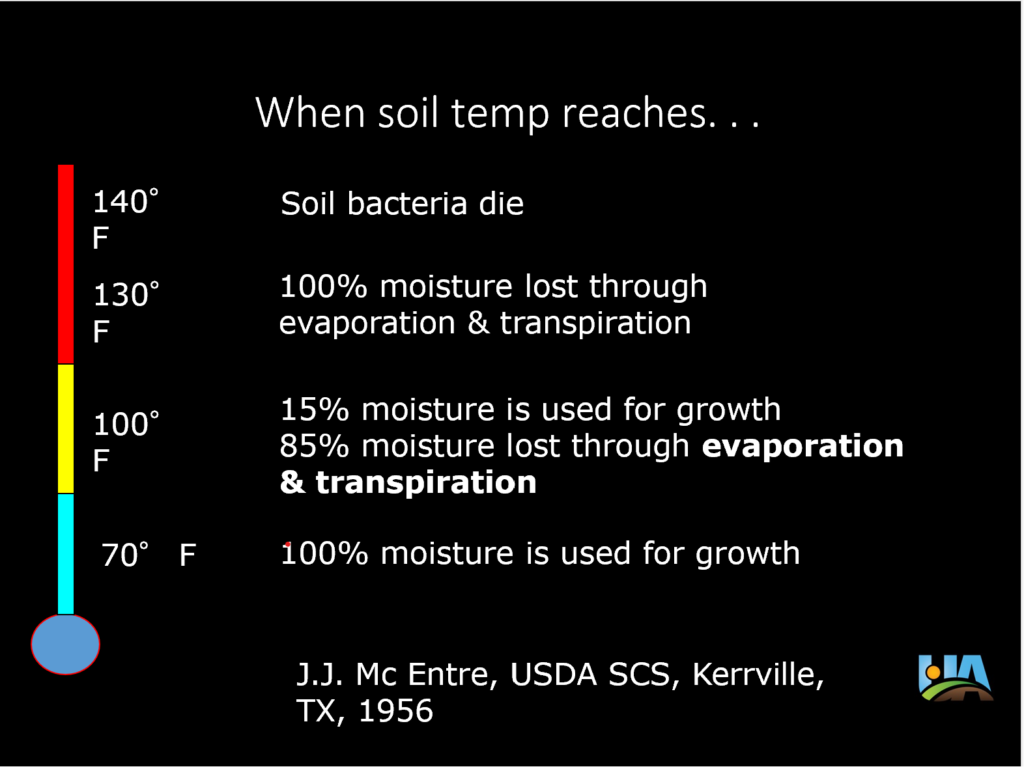
Whatever your opinion on climate change, we need to find common ground that unites us so we can all work together to move agriculture forward. While carbon is important, it’s become an increasingly polar topic that is driving an unnecessary wedge between us. Many folks also feel hopeless because they believe there’s no way one person can make an appreciable difference in the battle to reign in carbon. Water, on the other hand, may be the perfect condensation nucleus to rally around for three reason. 1) Water drives the majority of Earth’s heat dynamics, 2) Everyone knows they need it and 3) we can greatly influence it on the scale of the individual farm or ranch! Once we all join Team Water, the discussion about carbon can be introduced as it relates to water. At that point we can learn that carbon and water are joined at the atomic hip. You can’t have one without the other. In fact, many experts say that water follows carbon, and the availability of water seems to be the dominant control of carbon dioxide uptake by land vegetation.40,41,42 Even disasters like droughts, floods and fires are influenced by the Water Cycle just as much as the Carbon Cycle. Some might argue it’s a chicken-or-the-egg situation because they both rely on each other, but let’s remember which of the two makes life on Earth possible in the first place. The Moon and Mars have carbon stocks in the dirt, but they’re missing the two most basic ingredients for life: abundant water and a functioning Water Cycle. Take care of the Water Cycle and many, if not most, of our carbon problems will fix themselves.
Water in the Soil
Managing water on a farm, ranch or even a garden can be a difficult and expensive endeavor. Those of you in dryer parts of the world know this all too well! Unfortunately, water issues aren’t going away anytime soon, especially in the American West, as the term “mega drought” is being thrown around43 and aquifers continue to drain at rates faster than they’re recharging.44 We can do all the right things on a farm or ranch, but none of it matters if we don’t have water. Understanding the basics of soil science as it pertains to water infiltration, water-holding capacity and plant water-availability will give you the “why” behind many of the regenerative practices you hear so much about, like reducing tillage, increasing soil armor and having living roots in the soil for as many days of the year as possible. This way, you will be able to “catch your own fish and eat for a lifetime”, meaning you will have the knowledge to design the water-improving practices tailored to your unique context. In addition, you will know what to observe out in the field and how to adapt your management to ever-changing conditions.
First, it’s important to understand how water interacts with soil. To quote David Montgomery, soil is “curious stuff, part mineral and part organic, a weathered blanket of rotten rock and dead things.”45 In other words, everyone’s soil is just some combination of sand, silt, clay and organic matter. Each of these four components of soil have varying abilities to hold water due to their shape and electrical charge. Remember, water sticks to things with a positive or negative charge, but doesn’t interact much with neutral substances, like fats, oils and lipids. Clay particles are the smallest of the rotten rock portions and are flat like pieces of paper. This means the surface area of clay is much greater than that of silt and sand, so water has a difficult time physically draining through heavy clay soil. Clay is also unique in that numerous negative charges surround the exterior of each particle, which magnetically attracts the positively charge poles of a water molecule. All of these factors make heavy soils great at holding water, but not so great at letting it go. Farmers and ranchers know this intuitively because the portions of their fields with high clay content take longer to dry out than other areas. On the other hand, sand’s large and irregular shape provides a lot of space between each particle for water to drain downward. Its dearth of electrical charges also mean that water isn’t very attracted to sand in the first place. This can be an advantage in the spring when farmers need the ground to dry quickly so they can get equipment in the field to plant, but not such a great thing in the heat of the summer when sandy soils have the least amount of water to supply growing plants. Silts are in the middle and provide some of the benefits of both sand and clay. Assuming no one out there is farming on the beach, everyone’s soil is a combination of water holding clay, middling silt and aerating sand.
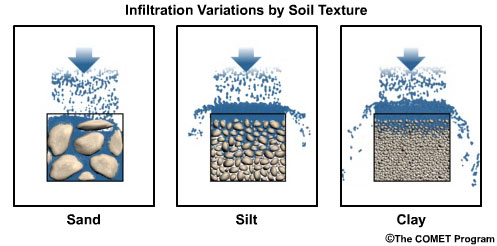
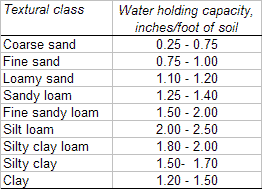

The percentage of sand, silt and clay in a soil is determined by 1) the weathering of local bedrock, which you can imagine takes a long time, and 2) the delivery of weathered material that was not originally from that area via wind, water, glacier or gravity. Substantial changes to soil composition require major climatic shifts that result in something like a glacier growing and receding, which can take hundreds or thousands of years. This means you get what you get, so don’t throw a fit… in terms of sand, silt and clay. The one portion of soil that we can change significantly in our lifetime is organic matter. Soil is much more than an inert heap of decayed rock that can hold water and nutrients for plant roots to slurp up. It’s alive! So alive that up to 59% of all life on Earth calls the soil its home.46 These living organisms are constantly reshaping the structure of soil and the composition of organic matter by moving, eating, drinking, excreting and, importantly, dying. Most organisms in the soil are microbes with short life spans, which means their dead bodies pile up in the soil. For this reason, most of the soil is more of a graveyard than a bustling metropolis of activity. Yes, living microbes consume organic matter ferociously when water, temperature and nutrient levels are ideal, but the truth is that over 99% of the area in most soils is considered a biological “cold spot” of activity.47 In addition, clay particles and good soil structure will “hide” organic matter from hungry packs of decomposers. More on this later. All in all, organic matter refers to these living, dead and decaying carbon-based organisms in the soil, as well as the organic substances they exude. Of these categories, organic matter is overwhelmingly composed of the dead and decaying portion, which accounts for roughly 90% of it by weight.48
Macroscopic and microscopic organisms decay similarly, largely due to the fact that microscopic ones do the majority of the work in both cases! Think about how a T Rex would have decomposed. Softer compounds that made up its skin, muscles, eyes, internal organs, etc. were the first to break down, while harder substances, like bone, stuck around for much longer. Bones are composed of “recalcitrant” compounds, meaning they are very stable and harder for microbes to decompose. Soft tissue is made up of “labile” compounds that microbes can break apart and readily consume to meet their metabolic needs. Plant residue, plant roots, arthropods and microbes in the soil are all made up of a combination of labile compounds that get broken down quickly and recalcitrant ones that stick around longer, like microscopic fossils. Organic compounds that are recalcitrant and/or hidden by proper soil structure can remain intact in the soil for centuries or millennia. This is what we call humus.
You may be asking yourself: what does any of that have to do with water? It has a lot to do with water because adding organic matter/humus to the soil is one of the best goals a producer can set in order to improve water infiltration, water-holding capacity and plant-available water. As organic compounds decompose, the recalcitrant carcasses of microbial and plant cells have numerous electrical charges on their exteriors that attract and hold water, just like clay. However, humus out-clays clay, because “gram for gram, the capacity of humus to hold nutrients and water is far greater than that of clay.”49 According to the USDA, organic matter holds approximately 10 to 1,000 times more water and nutrients than the same amount of soil minerals (sand, silt, and clay).50 This equates to an additional 10,800 L of water per acre in the top 6 inches for every 1% increase in OM in a soil that contains between 0-8% OM.51 That’s not all. Humic substances are far less dense than clay, which did come from dense rock after all, so water is able to drain through the soil profile once its exterior charges are occupied with water (or microbes or nutrients). Humus is the perfect hybrid of sand’s ability to drain water and clay’s ability to hold on to it. Walter Jehne famously calls organic matter “the soil carbon sponge” for its ability to hold large quantities of water and its porous structure.


Building organic matter levels in the soil is largely the result of vigorous biological activity and proper soil structure. These two factors build off of each other as biology builds soil structure and soil structure catalyzes more biological activity. Bacteria and fungi in the soil are two heavy hitters in this process. Like all other living creatures, they require food as building material and energy to power cellular processes. Plant roots are one of the best sources of food for these soil microbes because they provide easily consumable carbon compounds called exudates, which causes a frenzy of activity near the root. In addition, the root itself is a good source of food once it dies. Many farmers think residue on the soil surface is the way to build humus, but this is a misnomer as one ton of roots build two-to-three times more humus than one ton of aboveground residue.52
Living organisms not only need to take in external compounds, but they also excrete internal compounds outside of the boundaries of their bodies. Excreted compounds include products of waste, chemical warfare or environmental manipulation. Many of them happen to be sticky and attach themselves to surrounding objects. These sticky materials, along with dead and decaying microbes, glue particles of sand, silt and clay together to form what are called “microaggregates.” Microaggregates create a shield around microbial carcasses and other small bits of organic matter, which slows down their decomposition. That’s good news for building organic matter levels, but microaggregates are incredibly small and leave no pore space between them. This means a soil composed solely of microaggregates is a compacted soil. The solution is to glue these microaggregate structures together to form “macroaggregates”, which creates large channels of pore space between them, like marbles in a jar. Plant roots and a special type of fungus called mycorrhizal fungi work together to bring microaggregates in close proximity and cement them together. One of the most important cementing materials is called glomalin, which is composed of protein from the fungus and sugar from plant. The beauty of glomalin is that it is not water-soluble, so it won’t dissolve away in the presence of water, but water is still able to enter inside because glomalin encases the macroaggregate in a waxy, lattice-like pattern. The tricky part is that glomalin only sticks around for roughly a month as hungry soil microbes devour glomalin as a food source. Therefore, we need to feed the soil to keep our cement-producing fungi operating. If microbes eat all of the cement faster than replacement cement is produced, microaggregates will disperse and pore space will fill up again. When this happens on a large-scale, we see the reappearance of compaction in a field and previously hidden organic matter is quickly devoured by hungry microbes. Remember, roots are arguably the best way to feed the soil, so maintaining glomalin production is a major reason why keeping living roots in the ground for as many days as possible is a principle of soil health.

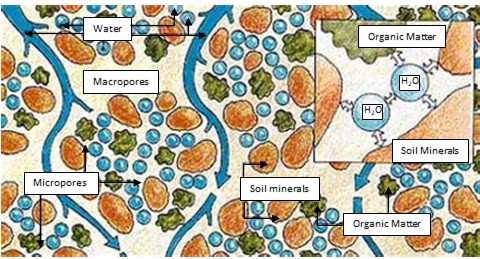
The bottom line: soils were designed to infiltrate precipitation quickly, hold on to vast quantities of it and release the water to growing plants as needed. Many production soils do not function this way because they have destroyed the macroaggregate structure and reduced the quantity of organic matter. Precipitation that falls on soil with low levels of macroaggregates and/or organic matter will often turn it into a muddy mess or pond on top like water on flour. Water that does infiltrate cannot be safely absorbed inside of the non-existent spongy marbles, so pore space becomes waterlogged, oxygen is quickly consumed and many beneficial organisms in the soil die. An easy test to visualize how well your soil is aggregated is the slake test. Place a dried clod of soil into a column of water and observe whether the sponge-like macroaggregates absorb the water and maintain the integrity of the soil, or whether the water gets in between the exposed microaggregates and forces the clod apart. Check out this video by Ray Archuleta explaining the process.

Managing Your Water Cycle
We’ve now reached the point where global talking points and scientific jargon meets individual action. The spotlight narrows down onto each one of us, especially those of us that manage farms, ranches or other tracts of land. It’s time to take matters into our own hands and collectively improve the Water Cycle in our townships, counties, states and nations.
First, we must ensure that our practices open up the soil surface to allow water to infiltrate. In his book Dirt to Soil, North Dakota farmer Gabe Brown details just how quickly water infiltration rates can increase after the implementation of regenerative practices. He writes, “When we purchased the farm in 1991, the infiltration rate on our cropland was only one half inch per hour. When a big storm came along, dumping two or three inches of rain, most of the water left the farm in a hurry, usually taking a bunch of topsoil with it. By 2009, the infiltration rate had risen to more than ten inches per hour thanks to well-aggregated soils due to mycorrhizal fungi and soil biology. The soil could absorb large volumes of water, which is exactly what happened on June 15, 2009. It started raining at 5:30 in the evening and kept raining, and raining. When the storm was over the following morning, we had received 13.6 inches of rain in twenty-two hours, but the vast majority had infiltrated into the soil. Jay Fuhrer visited the farm that day to see how our soils had held up, and he said that you could have driven a vehicle across the fields without making a rut.”53 Gabe’s story is a great example of what it means to focus on “effective rainfall”, which is the amount of rainfall that actually infiltrates into the soil, rather than looking simply at the amount of rainfall. After all, what good is it to get an inch of rain if the soil is so crusted over that very little of it infiltrates into the ground?
Reducing tillage is a great first step toward increasing water infiltration. Tillage physically breaks apart macroaggregates, which simultaneously
exposes organic matter to hungry microbes and stokes the microbial fire by infusing oxygen into the soil. These two factors result in the decomposition of organic matter at rates much faster than it can be built, thus reducing organic matter content over time in systems that utilize intensive tillage.54 In addition, fungal activity in soils is significantly lower in tilled soil compared to native or no-till systems.55 Essentially, the soil structure has been blown to smithereens along with the workers that built and maintain it. Bare soil hardens when exposed to sun, wind and rain, which explains why increases in water infiltration after tillage are very short-lived. In the case of rain, each of the millions of raindrops bombarding the soil surface is traveling at speeds up to 20 mph. If you don’t think think that’s very fast, watch a car driving at 20 mph and see how it would feel to get hit by it! Soil particles at the impact zone of each raindrop scatter up and out as if a miniature bomb has gone off, leaving a small crater of impacted soil that has been pounded down. After a rain, a layer of water will remain on the soil surface. Sands, silts and clays float in this layer of water until the heaviest particles, sand, start to fall to the bottom. Silt eventually follows suit, leaving a layer of clay still floating. Sun and wind dry out the soil surface, creating a waterproof lid of clay particles in a process that resembles the making of clay pots in a kiln. For this reason, we need to ensure that the soil is covered by living or dead plant residue at all times.
Diversity of cropping systems is also a proven strategy that maintains an open soil surface. Infiltration rates can increase up to 300% with the introduction of diverse crops, while also reducing water loss to evaporation and drainage, which results in higher crop productivity and stability.56 In addition, the general implementation of regenerative practices, such as abandoning some or all synthetic agrichemicals, planting perennial ground covers, integrating livestock, maintaining non-crop habitat, and using composts and compost teas, on 4 California almond orchards resulted in water infiltration rates six-fold higher than paired conventional almond orchards.57 This is likely one major reason why profit on the regenerative orchards was reported as being twice as high as the conventional orchards. It’s amazing what will happen when we encourage water to enter the soil!
If you haven’t done so yet, the single ring water infiltration test is a simple and informative test to give you an idea of how quickly your soils are able to infiltrate water. Water infiltration is a powerful data point to track over time to see the effect of management change.
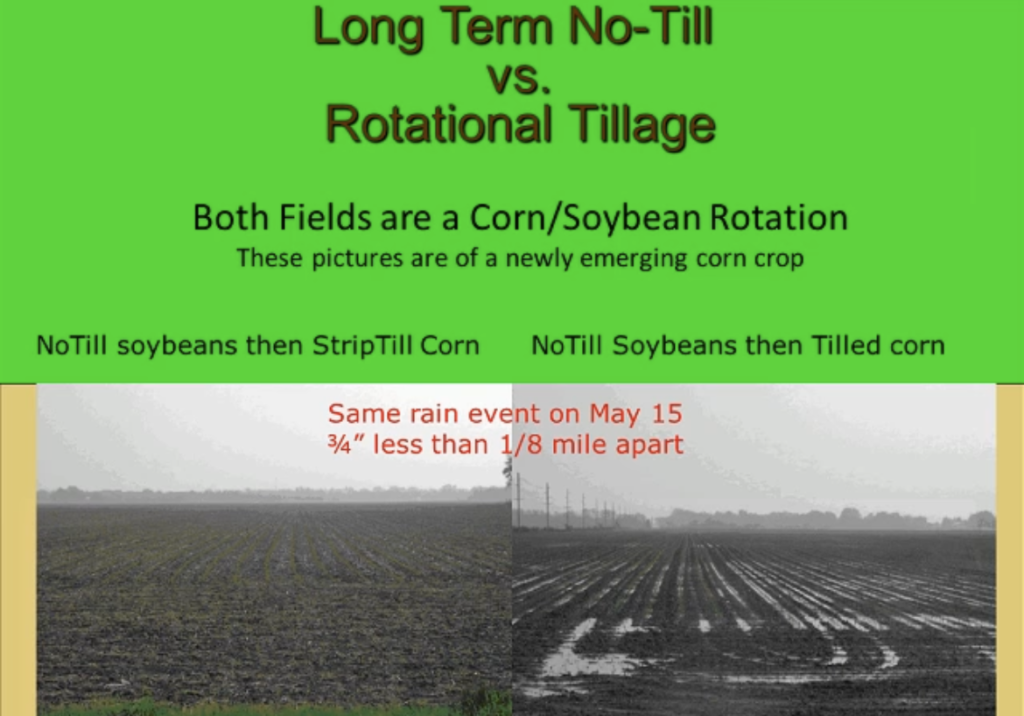
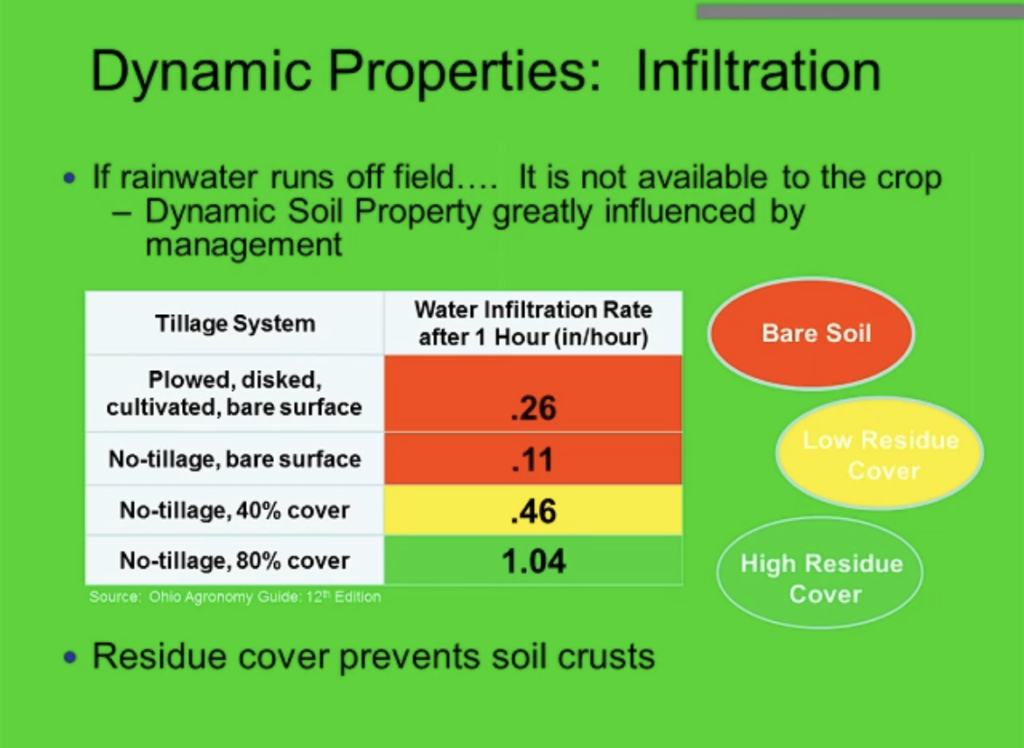
Once water is able to infiltrate into the soil, we need to make sure there is sufficient pore space for water to percolate through the soil profile. This means improving macroaggreagtion and eradicating any hardpan layers. The key to accomplishing these tasks is understanding that compaction and hardpan issues are chiefly biological problems, not physical, chemical or mechanical. It takes a thriving biological community to create good soil structure and maintain it. Understanding Ag’s Brian Dougherty discusses the importance of biology in compaction in this webinar from 2023. Heavy machinery can certainly be a nice tool to use in certain cases, but it does not fix compaction and it certainly doesn’t build soil structure. Practices like subsoiling must be followed by a change in management or else the same problems will reemerge due to the continuation of practices that caused the problem in the first place! Mark Shepard, author of Water for Any Farm, drives this point home even further by saying, “water is life… No matter what you are going to to plant, no matter what animals will be a part of your system- from a large cattle operation to a suburbanite with a small chicken tractor- slow, spread and soak water into the soil and life will thrive.”58
Water carries enormous amounts of energy as it moves across the landscape, so it’s imperative that it gets slowed down to a healthy pace as it flows through the landscape. Canyons and gullies are evidence of what happens when water is allowed to flow at high rates. Similarly, losing annual layers of soil measuring only a millimeter thick is just as powerful even though it may not be as visible. Estimates show that the average loss of topsoil from American cultivated cropland is 2 tons/acre/year59 and that the Midwestern US has lost 57 trillion metric tons of soil due to agricultural practices in the last 160 years.60 Regenerative practices like utilizing cover crops, integrating livestock to graze them and maintaining soil armor slow down water and allow it to soak into the soil. This Goldilocks pace of water movement channels energy into supporting soil-building life rather than washing them and their homes down the river. Check out this video of a rainfall simulator showing how different management styles affect erosion and water percolation. WARNING: be prepared to change as the rainfall simulator test has shifted more paradigms than any other demonstration.
Crop production, especially annual crop production, requires a lot of management to have a successful harvest year-in and year-out, which is why we’ve focused on this system so far. Regenerative agriculture pioneers are showing that we can hand off this management to our underground herd, which will build soil health rather than destroy it. It’s not easy and requires a lot of time and thought, but we can certainly make great strides in increasing water efficiency in these systems. But cropping systems aren’t the only ones that affect the Water Cycle. Improper grazing will cap, compact and degrade the soil just as quickly as in cropping systems. Numerous studies are now available that show how continuous grazing negatively impacts the Water Cycle, while adaptive, multi-paddock (AMP) grazing can greatly improve it. For example, one study found heavy continuous grazing increased surface runoff by 47% and decreased infiltration by 5% compared to AMP counterparts.61 Two recent studies also found a significant decrease in water infiltration rates on ground that had been continuously grazed compared to AMP managed ground.62,63 Implementing AMP grazing and accruing these benefits to the Water Cycle lead to increases in forage production64,65, which sets off a chain reaction of positive compounding and cascading effects, such as macroaggregate buidling, soil fungi proliferation and even flood reduction.66
These benefits are especially important for ranchers in semi-arid and arid environments because they need to capture and use every single drop that falls on their land. AMP ranchers in these conditions are discovering the huge impact they can have, not only on using rainfall more efficiently, but also in creating more rain. You read that right. Ranches occupying large swaths of land, typically 10,000 contiguous acres and above, are finding that increasing forage production and, consequently, plant transpiration, is influencing changes to the Water Cycle of atmospheric proportions. Take Alejandro Carillo’s ranch in Chihuahua, Mexico. In an article titled,Regenerative Rainmaking, Dr. Allen Williams and Alejandro describe how regenerative grazing in the desert has led to documented increases in precipitation over time compared to neighboring conventionally managed ranches. Some ranches are receiving one to two inches more rain, which is incredible in a region that averages around seven inches per year. All it takes is utilizing livestock in a way that mimics nature to stimulate plant growth and improve soil health. This is extremely encouraging for so many reasons, not least of which is the impact this can have on reversing desertification in these arid regions of the world.
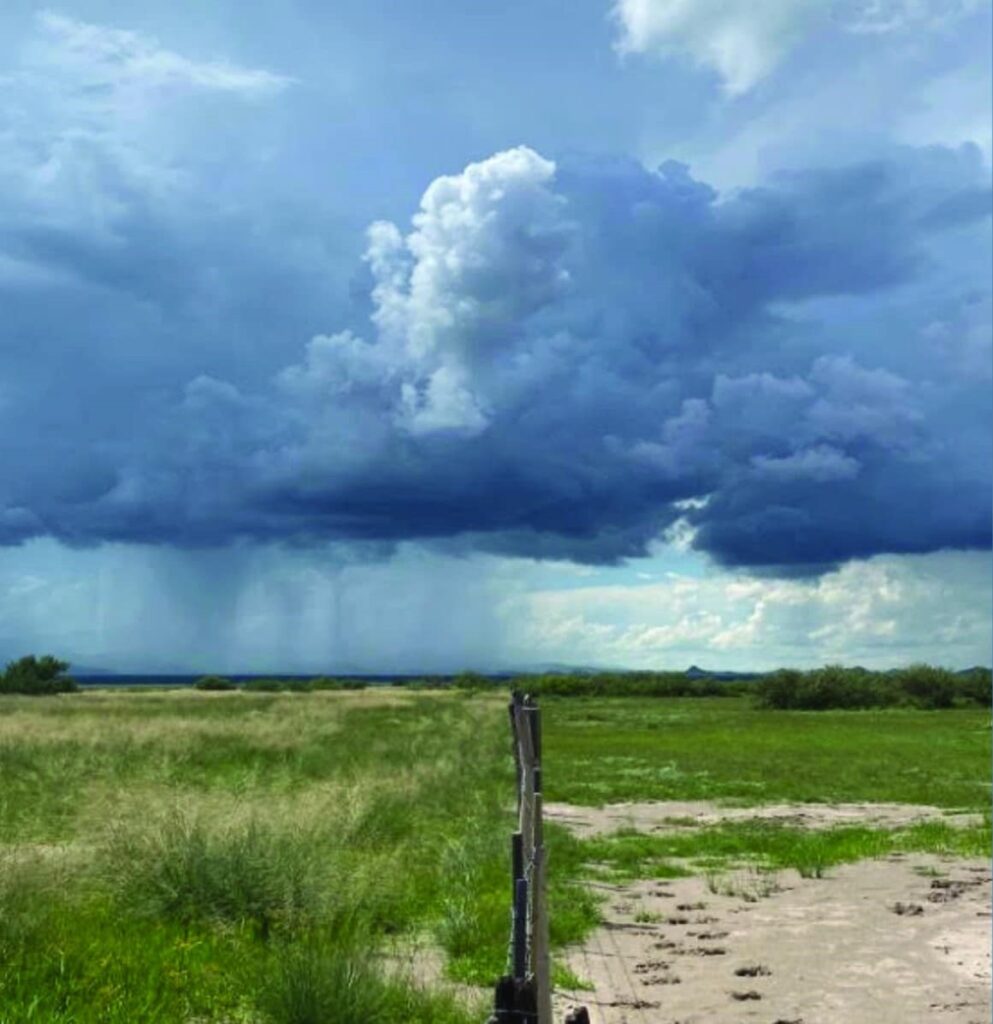
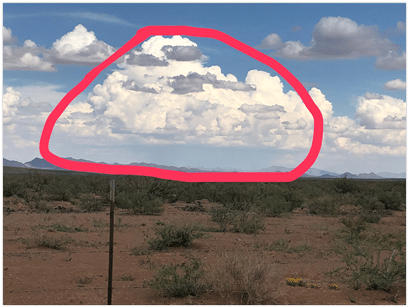
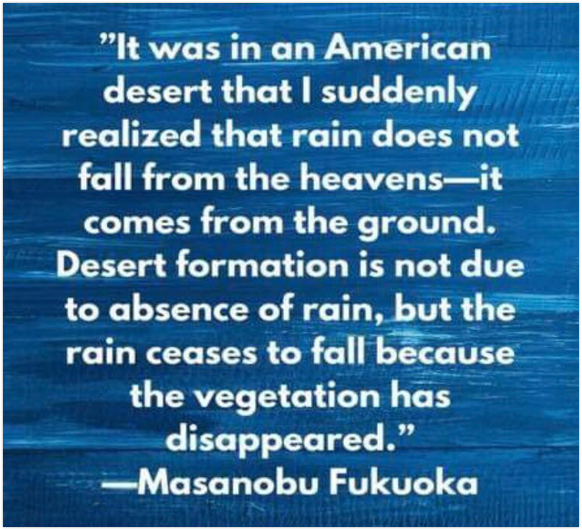
Managing water efficiently on both cropland and pastureland boils down to the same principle: slow, spread and soak as much water as we can to promote life. Life will beget balance, health and more life. That’s how nature works. I encourage everyone to stick a shovel into their fencelines, prairies and woods to see what the soil used to look like. Observe the level of aggregation, moisture levels and color. Pull soil samples from them as well and compare them to production fields and pastures. Some people even go out into a storm and observe how the rain interacts differently on the land they manage compared to more native landscapes! You might look a little cooky, but these exercises will help you understand that your long-term management practices determine the erodability, structure and infiltration capacity of the soil.
Check out the drastic difference below between soil on a conventionally managed cropland field versus undisturbed soil mere yards away to get an idea of what you might find on your operation. Think about how water will interact with each of these soils. Will it become runoff, taking nutrient-rich topsoil with it to the river, or will it slowly infiltrate into the soil? Are there plenty of aggregates with organic matter that will hold infiltrated water for future use? Do the roots have access to the water table through functioning soil “pipes” or is there a distinct hardpan that cuts off plants from this abundant source of water? These are important questions that we should be asking to get answers that will guide regenerative decision-making.
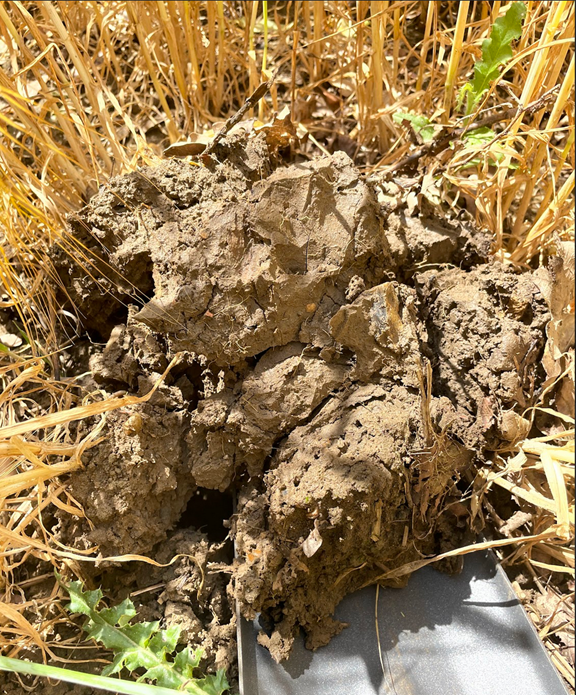
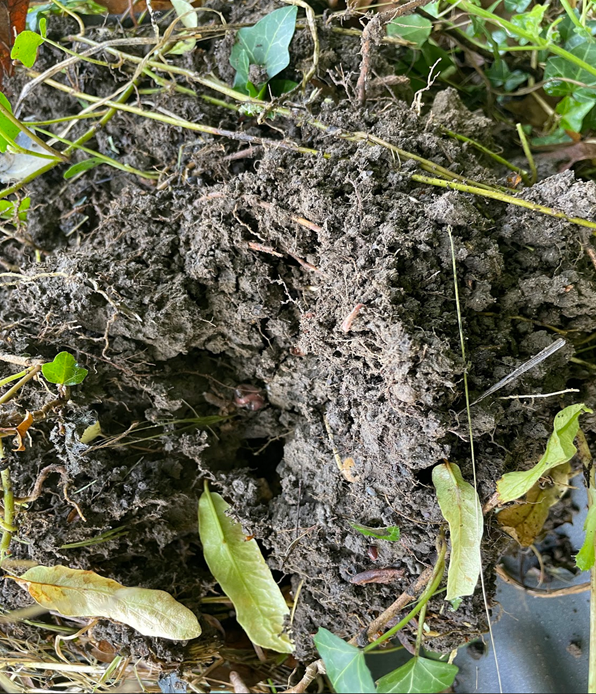
Summary
American students grow up thinking about different subjects in isolation. We don’t give much thought to how chemistry influences music, how physics influences economics or how history influences biology. This is a problem because the world is connected and each subject is woven together in a beautiful tapestry. The Large and Small Water Cycles are a prime example of this concept, as they are influenced by, and influence, the other ecosystem processes, namely the Energy Cycle, the Nutrient Cycle and Cycle of Life, or Community Dynamics. Broken down further, each of these cycles is influenced by soil health, plant production and animal interaction with the land. Large-scale astronomical and climatic events, as well as social sciences, are all important factors that also deserve consideration when discussing the Water Cycle. It’s really complicated and makes a lot of folks think they live at the mercy of the events that happen around them. It’s easy to develop a victim mentality under those mental circumstances. I don’t blame anyone for feeling this way, because farming and ranching is tough, and Mother Nature calls many of the shots. However, it’s equally true that we can increase the resilience and productivity of our operations by controlling the controllables, especially when it comes to water management. Practitioners the world around have increased infiltration rates, water holding capacity and plant productivity over time by using the Six Principles of Soil Health and the Three Rules of Adaptive Stewardship as a framework for decision-making. This should bring you hope because it means you have real agency to positively influence the Water Cycle on your operation. You are a victor, not a victim! Therefore, I challenge you to define your relationship with water. Is it healthy or is it on-again-off-again? Is it complicated? Are you two divorced? You’d better hope not. I also challenge you to think about how past management decisions have influenced the Water Cycle on your operation because, like with human relationships, our behaviors do influence the outcome. Perhaps after this bout of introspection you might be willing to strengthen your relationship with water by admitting, “It’s not you, it’s me”.
References
1https://www.discovery.com/space/how-common-are-water-worlds-in-the-galaxy-
3 https://pubmed.ncbi.nlm.nih.gov/17739617/
4https://collaborate.princeton.edu/en/publications/climate-and-the-collapse-of-maya-civilization
5https://www.science.org/doi/10.1126/science.1216629
6https://www.science.org/doi/10.1126/science.aas9871
7https://amzn.to/3FDguIH (pg. 433)
10https://coagmet.colostate.edu/extended_etr_about.php
11https://wwf.panda.org/wwf_news/?232041/The-Future-Climate-of-Amazonia
12https://journals.ametsoc.org/view/journals/clim/25/2/2011jcli4189.1.xml
13https://hess.copernicus.org/articles/11/1013/2007/hess-11-1013-2007.pdf
15https://www.un.org/esa/forests/wp-content/uploads/2018/04/UNFF13_BkgdStudy_ForestsWater.pdf
16https://www.scientificamerican.com/article/cutting-down-rainforests/
17https://www.nature.com/articles/nature11983
18https://agupubs.onlinelibrary.wiley.com/doi/full/10.1029/2003JD003545
19https://www.mdpi.com/2073-4433/10/12/786
20https://www.science.org/doi/10.1126/science.1191056
21https://www.nature.com/articles/s41467-020-18424-6
22https://news.agu.org/press-release/pollen-and-clouds-april-flowers-bring-may-showers/
23https://smokymountainnationalpark.com/blog/why-are-the-smoky-mountains-smokey/
24https://www.pnas.org/doi/pdf/10.1073/pnas.101122798
27https://www.theguardian.com/commentisfree/2017/apr/03/climate-change-water-fossil-fuel
28https://agupubs.onlinelibrary.wiley.com/doi/full/10.1029/2009RG000301
31 https://www.nature.com/articles/s41467-019-09535-w
32https://climate.mit.edu/explainers/urban-heat-islands
33https://link.springer.com/article/10.1007/s00382-021-06105-z
34http://waterparadigm.org/indexen.php?web=./home/homeen.html
35https://lambdageeks.com/lunar-surface-temperatures/
37https://www.farmprogress.com/corn/all-you-ever-wanted-to-know-about-soil-temperature
38https://www.farmprogress.com/crops/7-facts-you-didn-t-know-about-soil-temperature
39https://understandingag.com/the-heat-is-on/
40https://www.nature.com/articles/nature20780
41https://www.nature.com/articles/s41586-018-0424-4
42https://www.nature.com/articles/s41586-018-0848-x
43https://www.nature.com/articles/s41558-022-01290-z
44https://www.nytimes.com/interactive/2023/08/28/climate/groundwater-drying-climate-change.html
46https://www.pnas.org/doi/abs/10.1073/pnas.2304663120
47https://journals.plos.org/ploscompbiol/article?id=10.1371/journal.pcbi.1009857
48https://www.agric.wa.gov.au/measuring-and-assessing-soils/what-soil-organic-carbon
51https://www.jswconline.org/content/73/4/411
54https://environmentalevidencejournal.biomedcentral.com/articles/10.1186/s13750-017-0108-9
55https://www.sciencedirect.com/science/article/abs/pii/S0038071702000330
56https://www.researchgate.net/publication/365925405_Crop_diversification_and_soil_water
57https://www.frontiersin.org/articles/10.3389/fsufs.2021.664359/full
59https://arxiv.org/ftp/arxiv/papers/2207/2207.06579.pdf
60https://www.sciencedaily.com/releases/2022/03/220316114958.htm
61https://pubmed.ncbi.nlm.nih.gov/29401363/
62https://www.sciencedirect.com/science/article/abs/pii/S0016706121003943
63https://carboncowboys.org/images/published_research/pdfs/apfelbaum-veg_infitration_carbon_2022.pdf
64https://peerj.com/articles/13750/
65https://www.tandfonline.com/doi/abs/10.1080/21683565.2019.1591564
66https://www.sciencedirect.com/science/article/abs/pii/S0167880917300671